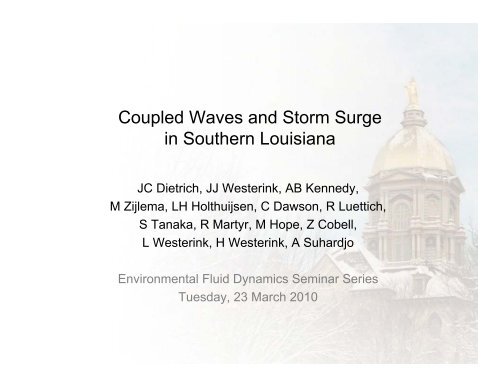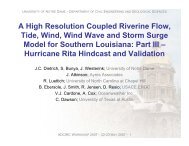Coupled Waves and Storm Surge in Southern ... - Casey Dietrich
Coupled Waves and Storm Surge in Southern ... - Casey Dietrich
Coupled Waves and Storm Surge in Southern ... - Casey Dietrich
You also want an ePaper? Increase the reach of your titles
YUMPU automatically turns print PDFs into web optimized ePapers that Google loves.
<strong>Coupled</strong> <strong>Waves</strong> <strong>and</strong> <strong>Storm</strong> <strong>Surge</strong><br />
<strong>in</strong> <strong>Southern</strong> Louisiana<br />
JC <strong>Dietrich</strong>, JJ Wester<strong>in</strong>k, AB Kennedy,<br />
M Zijlema, LH Holthuijsen, C Dawson, R Luettich,<br />
S Tanaka, R Martyr, M Hope, Z Cobell,<br />
L Wester<strong>in</strong>k, H Wester<strong>in</strong>k, A Suhardjo<br />
Environmental Fluid Dynamics Sem<strong>in</strong>ar Series<br />
Tuesday, 23 March 2010
The Orig<strong>in</strong>al:<br />
‘Loose’ Coupl<strong>in</strong>g of <strong>Waves</strong> <strong>and</strong> <strong>Surge</strong> dur<strong>in</strong>g Katr<strong>in</strong>a<br />
S. Bunya, et al. (2010). "A High-Resolution <strong>Coupled</strong> River<strong>in</strong>e Flow, Tide, W<strong>in</strong>d, W<strong>in</strong>d Wave, <strong>and</strong> <strong>Storm</strong> <strong>Surge</strong> Model for<br />
<strong>Southern</strong> Louisiana <strong>and</strong> Mississippi, Part I: Model Development <strong>and</strong> Validation." Monthly Weather Review 138, 345-377.<br />
J.C. <strong>Dietrich</strong>, et al. (2010). "A High-Resolution <strong>Coupled</strong> River<strong>in</strong>e Flow, Tide, W<strong>in</strong>d, W<strong>in</strong>d Wave, <strong>and</strong> <strong>Storm</strong> <strong>Surge</strong> Model<br />
for <strong>Southern</strong> Louisiana <strong>and</strong> Mississippi, Part II: Synoptic Description <strong>and</strong> Analysis of Hurricanes Katr<strong>in</strong>a <strong>and</strong> Rita." Monthly<br />
Weather Review 138, 378-404.
<strong>Southern</strong> Louisiana
SL15v7l : Bathymetry <strong>and</strong> Topography
SL15v7l : Bathymetry <strong>and</strong> Topography
SL15v7l : Mesh Sizes
ADCIRC : Background <strong>and</strong> Govern<strong>in</strong>g Equations<br />
ADvanced CIRCulation:<br />
• Developed by Wester<strong>in</strong>k, Luettich, <strong>and</strong> many others<br />
• Cont<strong>in</strong>uous-Galerk<strong>in</strong>, f<strong>in</strong>ite-element, shallow-water model<br />
• Solves for water levels <strong>and</strong> currents at a range of scales<br />
• From rivers <strong>and</strong> tides to w<strong>in</strong>d-driven storm surge<br />
• Resolution can vary from 20-30km to 30-50m<br />
• Solves the Generalized Wave Cont<strong>in</strong>uity Equation (GWCE):<br />
where: H = ζ + h is the total water depth, U <strong>and</strong> V are the depthaveraged<br />
velocities, <strong>and</strong> τ 0 is a numerical parameter
ADCIRC : Background <strong>and</strong> Govern<strong>in</strong>g Equations<br />
ADvanced CIRCulation:<br />
• Solves the vertically-<strong>in</strong>tegrated momentum equations:<br />
<strong>and</strong>:<br />
where: f is the Coriolis parameter, P s is atmospheric pressure, ρ 0 is the<br />
reference density of water, τ s <strong>and</strong> τ b are stresses at the surface <strong>and</strong><br />
bottom, M is a lateral stress gradient, B is a barocl<strong>in</strong>ic pressure<br />
gradient, <strong>and</strong> D is momentum dispersion
Katr<strong>in</strong>a : Track
Katr<strong>in</strong>a : Water Levels : 2005/08/29/0000Z
Katr<strong>in</strong>a : Water Levels : 2005/08/29/0100Z
Katr<strong>in</strong>a : Water Levels : 2005/08/29/0200Z
Katr<strong>in</strong>a : Water Levels : 2005/08/29/0300Z
Katr<strong>in</strong>a : Water Levels : 2005/08/29/0400Z
Katr<strong>in</strong>a : Water Levels : 2005/08/29/0500Z
Katr<strong>in</strong>a : Water Levels : 2005/08/29/0600Z
Katr<strong>in</strong>a : Water Levels : 2005/08/29/0700Z
Katr<strong>in</strong>a : Water Levels : 2005/08/29/0800Z
Katr<strong>in</strong>a : Water Levels : 2005/08/29/0900Z
Katr<strong>in</strong>a : Water Levels : 2005/08/29/1000Z
Katr<strong>in</strong>a : Water Levels : 2005/08/29/1100Z
Katr<strong>in</strong>a : Water Levels : 2005/08/29/1200Z
Katr<strong>in</strong>a : Water Levels : 2005/08/29/1300Z
Katr<strong>in</strong>a : Water Levels : 2005/08/29/1400Z
Katr<strong>in</strong>a : Water Levels : 2005/08/29/1500Z
Katr<strong>in</strong>a : Water Levels : 2005/08/29/1600Z
Katr<strong>in</strong>a : Water Levels : 2005/08/29/1700Z
Katr<strong>in</strong>a : Water Levels : 2005/08/29/1800Z
Katr<strong>in</strong>a : Water Levels : 2005/08/29/1900Z
Katr<strong>in</strong>a : Water Levels : 2005/08/29/2000Z
Katr<strong>in</strong>a : Water Levels : 2005/08/29/2100Z
Katr<strong>in</strong>a : Water Levels : 2005/08/29/2200Z
Katr<strong>in</strong>a : Water Levels : 2005/08/29/2300Z
Katr<strong>in</strong>a : Water Levels : 2005/08/30/0000Z
Katr<strong>in</strong>a : Water Levels : Maximum
Katr<strong>in</strong>a : URS/FEMA High-Water Marks
Katr<strong>in</strong>a : USACE High-Water Marks
Katr<strong>in</strong>a : Nearshore STWAVE Doma<strong>in</strong>s
Katr<strong>in</strong>a : Significant Wave Heights : Maximum
Katr<strong>in</strong>a : Radiation Stress Gradients : Maximum
Katr<strong>in</strong>a : Wave-Driven Setup : Maximum
The Change:<br />
‘Tight’ Coupl<strong>in</strong>g of SWAN+ADCIRC<br />
J.C. <strong>Dietrich</strong>, et al. (2010). "Model<strong>in</strong>g Hurricane <strong>Waves</strong> <strong>and</strong> <strong>Storm</strong> <strong>Surge</strong> us<strong>in</strong>g Integrally-<strong>Coupled</strong>, Scalable Computations."<br />
Journal of Atmospheric <strong>and</strong> Oceanic Technology, <strong>in</strong> review.
Disadvantages of ‘Loose’ Coupl<strong>in</strong>g<br />
1. Interpolation at Wave Model Boundaries<br />
2. Coverage <strong>in</strong> Deep Water<br />
3. Iteration<br />
• Models coupled through <strong>in</strong>put files<br />
• W<strong>in</strong>ds, water levels <strong>and</strong> currents passed to wave model<br />
• Radiation stress gradients passed to ADCIRC<br />
• Process can be automated, but is still <strong>in</strong>efficient<br />
ζ, u, v<br />
ADCIRC<br />
Wave Model<br />
F x<br />
, F y
Disadvantages of ‘Loose’ Coupl<strong>in</strong>g<br />
4. Interpolation:<br />
• Wave <strong>and</strong> circulation models run on different grids<br />
• Wave models on structured meshes<br />
• ADCIRC on unstructured, f<strong>in</strong>ite element mesh<br />
• Results must be <strong>in</strong>terpolated onto each mesh
Disadvantages of ‘Loose’ Coupl<strong>in</strong>g<br />
5. Resolution <strong>in</strong> wave break<strong>in</strong>g zones:<br />
• Circulation model has no knowledge of wave break<strong>in</strong>g<br />
• Must over-resolve these zones
‘Tight’ Coupl<strong>in</strong>g of SWAN+ADCIRC<br />
Simulat<strong>in</strong>g WAves Nearshore:<br />
• Developed by Booij, Holthuijsen, Zijlema at Delft University<br />
• Non-phase-resolv<strong>in</strong>g, wave energy propagation model<br />
• Solves the action balance equation:<br />
where: N(σ,θ) is the action density; c λ <strong>and</strong> c φ are the propagation<br />
velocities <strong>in</strong> geographic space (λ,φ); c σ <strong>and</strong> c θ are the propagation<br />
velocities <strong>in</strong> spectral space (σ,θ); <strong>and</strong> S tot is the source/s<strong>in</strong>k term that<br />
represents wave generation, dissipation, etc.
‘Tight’ Coupl<strong>in</strong>g of SWAN+ADCIRC<br />
Advantages:<br />
• SWAN <strong>and</strong> ADCIRC run on the same mesh<br />
• No nest<strong>in</strong>g of meshes<br />
• No overlapp<strong>in</strong>g of meshes<br />
• SWAN <strong>and</strong> ADCIRC run on the same core<br />
• No <strong>in</strong>terpolation<br />
• No global message pass<strong>in</strong>g<br />
• Optimization of code<br />
• No iteration of models<br />
• No overhead for coupl<strong>in</strong>g model<strong>in</strong>g framework<br />
• Utilize shared memory on multi-core processors<br />
• Optimization of physics<br />
• No need for directionality <strong>in</strong> wave model<br />
• Dynamic h- <strong>and</strong> p-adaptivity
‘Tight’ Coupl<strong>in</strong>g of SWAN+ADCIRC<br />
Schematic of Coupl<strong>in</strong>g:<br />
• ADCIRC is run for 600 seconds (∆t = 1 sec)<br />
• Water levels (ζ) <strong>and</strong> currents (u,v) are passed to SWAN<br />
• SWAN is run for 600 seconds (∆t = 600 sec)<br />
• Radiation stresses (S xx , S xy , S yy ) <strong>and</strong> their gradients (F x , F y ) are<br />
computed; gradients are passed to ADCIRC<br />
• Repeat<br />
Time:<br />
ADCIRC:<br />
0 600 1200<br />
1800 2400<br />
SWAN:<br />
• SWAN <strong>and</strong> ADCIRC are always extrapolat<strong>in</strong>g <strong>in</strong> time
‘Tight’ Coupl<strong>in</strong>g of SWAN+ADCIRC
‘Tight’ Coupl<strong>in</strong>g of SWAN+ADCIRC
‘Tight’ Coupl<strong>in</strong>g of SWAN+ADCIRC<br />
SWAN+ADCIRC<br />
ADCIRC<br />
SWAN
Katr<strong>in</strong>a : Significant Wave Heights : 2005/09/28/0000Z
Katr<strong>in</strong>a : Significant Wave Heights : 2005/09/28/0400Z
Katr<strong>in</strong>a : Significant Wave Heights : 2005/09/28/0800Z
Katr<strong>in</strong>a : Significant Wave Heights : 2005/09/28/1200Z
Katr<strong>in</strong>a : Significant Wave Heights : 2005/09/28/1600Z
Katr<strong>in</strong>a : Significant Wave Heights : 2005/09/28/2000Z
Katr<strong>in</strong>a : Significant Wave Heights : 2005/09/29/0000Z
Katr<strong>in</strong>a : Significant Wave Heights : 2005/09/29/0400Z
Katr<strong>in</strong>a : Significant Wave Heights : 2005/09/29/0800Z
Katr<strong>in</strong>a : Significant Wave Heights : 2005/09/29/1200Z
Katr<strong>in</strong>a : Significant Wave Heights : 2005/09/29/1600Z
Katr<strong>in</strong>a : Significant Wave Heights : 2005/09/29/2000Z
Katr<strong>in</strong>a : Significant Wave Heights : 2005/09/30/0000Z
Katr<strong>in</strong>a : Significant Wave Heights : Maximum
Katr<strong>in</strong>a : Radiation Stress Gradients : Maximum
Katr<strong>in</strong>a : Wave-Driven Setup : Maximum
Katr<strong>in</strong>a : Validation of Wave Parameters : NDBC
Katr<strong>in</strong>a : Validation of Wave Parameters : NDBC 42003<br />
42003
Katr<strong>in</strong>a : Validation of Wave Parameters : NDBC 42036<br />
42036
Katr<strong>in</strong>a : Validation of Wave Parameters : NDBC 42039<br />
42039
Katr<strong>in</strong>a : Validation of Wave Parameters : NDBC 42040<br />
42040
Katr<strong>in</strong>a : Validation of Wave Parameters : NDBC 42007<br />
42007
Katr<strong>in</strong>a : Validation of Wave Parameters : NDBC 42001<br />
42001
Katr<strong>in</strong>a : Validation of Wave Parameters : NDBC 42038<br />
42038
Katr<strong>in</strong>a : Validation of Wave Parameters : NDBC 42002<br />
42002
Katr<strong>in</strong>a : Validation of Wave Parameters : NDBC 42055<br />
42055
Katr<strong>in</strong>a : Validation of Wave Parameters : NDBC 42035<br />
42035
Katr<strong>in</strong>a : Validation of Wave Parameters : NDBC 42019<br />
42019
Katr<strong>in</strong>a : Validation of Wave Parameters : NDBC 42020<br />
42020
The New:<br />
SWAN+ADCIRC H<strong>in</strong>dcast of Gustav<br />
J.C. <strong>Dietrich</strong>, et al. (2010). “Hurricane Gustav (2008) <strong>Waves</strong>, <strong>Storm</strong> <strong>Surge</strong> <strong>and</strong> Currents: H<strong>in</strong>dcast <strong>and</strong> Synoptic Analysis <strong>in</strong><br />
<strong>Southern</strong> Louisiana." Monthly Weather Review, <strong>in</strong> preparation.
SL16v18c3 : Bathymetry <strong>and</strong> Topography
SL16v18c3 : Bathymetry <strong>and</strong> Topography
SL16v18c3 : Mesh Sizes
Gustav : Track<br />
2008/09/01/1400Z
Gustav : W<strong>in</strong>ds : 2008/09/01/1400Z
Gustav : Significant Wave Heights : 2008/09/01/1400Z
Gustav : Radiation Stress Gradients : 2008/09/01/1400Z
Gustav : Water Levels : 2008/09/01/1400Z
Gustav : Currents : 2008/09/01/1400Z
Increased Availability of Measurement Data<br />
Katr<strong>in</strong>a (2005)<br />
Gustav (2008)<br />
High-Water Marks<br />
Total:<br />
399<br />
Total:<br />
82<br />
URS/FEMA<br />
193<br />
URS/FEMA<br />
82<br />
USACE<br />
206<br />
Time Series<br />
Water Levels:<br />
9<br />
Water Levels:<br />
184<br />
NOS<br />
2<br />
NWS<br />
1<br />
USGS (Permanent)<br />
6<br />
USGS (Permanent)<br />
44<br />
USGS (Deployable)<br />
42<br />
NOAA<br />
26<br />
USACE<br />
46<br />
ND (Kennedy)<br />
16<br />
USACE (Smith)<br />
6<br />
Wave Parameters:<br />
14<br />
Wave Parameters:<br />
39<br />
NDBC<br />
12<br />
NDBC<br />
12<br />
CSI<br />
2<br />
CSI<br />
5<br />
ND (Kennedy)<br />
16<br />
USACE (Smith)<br />
6
Gustav : Validation of Wave Parameters : AK
Gustav : Validation of Wave Parameters : AK 20<br />
20<br />
Bathymetry at Gage:<br />
Kennedy: 23.1<br />
ADCIRC: 18.7
Gustav : Validation of Wave Parameters : AK 18<br />
18<br />
Bathymetry at Gage:<br />
Kennedy: 10.7<br />
ADCIRC: 17.4
Gustav : Validation of Wave Parameters : AK 19<br />
19<br />
Bathymetry at Gage:<br />
Kennedy: 15.4<br />
ADCIRC: 14.8
Gustav : Validation of Wave Parameters : AK 17<br />
17<br />
Bathymetry at Gage:<br />
Kennedy: 4.6<br />
ADCIRC: 3.2
Gustav : Validation of Wave Parameters : AK 12<br />
12<br />
Bathymetry at Gage:<br />
Kennedy: 14.0<br />
ADCIRC: 11.1
Gustav : Validation of Wave Parameters : AK 14<br />
14<br />
Bathymetry at Gage:<br />
Kennedy: 1.4<br />
ADCIRC: 1.2
Gustav : Validation of Wave Parameters : AK 13<br />
13<br />
Bathymetry at Gage:<br />
Kennedy: 1.8<br />
ADCIRC: 1.2
Gustav : Validation of Wave Parameters : AK 11<br />
11<br />
Bathymetry at Gage:<br />
Kennedy: 3.5<br />
ADCIRC: 1.2
Gustav : Validation of Wave Parameters : AK 9<br />
9<br />
Bathymetry at Gage:<br />
Kennedy: 6.9<br />
ADCIRC: 1.0
Gustav : Validation of Wave Parameters : AK 8<br />
8<br />
Bathymetry at Gage:<br />
Kennedy: 10.6<br />
ADCIRC: 9.4
Gustav : Validation of Wave Parameters : AK 1<br />
1<br />
Bathymetry at Gage:<br />
Kennedy: 7.0<br />
ADCIRC: 5.5
Gustav : Validation of Wave Parameters : AK 2<br />
2<br />
Bathymetry at Gage:<br />
Kennedy: 3.7<br />
ADCIRC: 3.9
Gustav : Validation of Wave Parameters : AK 7<br />
7<br />
Bathymetry at Gage:<br />
Kennedy: 5.1<br />
ADCIRC: 6.3
Gustav : Validation of Wave Parameters : AK 6<br />
6<br />
Bathymetry at Gage:<br />
Kennedy: 3.2<br />
ADCIRC: 2.9
Gustav : Validation of Wave Parameters : AK 5<br />
5<br />
Bathymetry at Gage:<br />
Kennedy: 7.7<br />
ADCIRC: 6.1
Gustav : Validation of Wave Parameters : AK 4<br />
4<br />
Bathymetry at Gage:<br />
Kennedy: 6.2<br />
ADCIRC: 6.0
The Way Ahead:<br />
Conclusions <strong>and</strong> Future Work
Conclusions <strong>and</strong> Future Work<br />
‘Loose’ Coupl<strong>in</strong>g of <strong>Waves</strong> <strong>and</strong> <strong>Surge</strong> dur<strong>in</strong>g Katr<strong>in</strong>a<br />
• Successful h<strong>in</strong>dcasts of Katr<strong>in</strong>a <strong>and</strong> Rita<br />
• WAM <strong>and</strong> STWAVE were clunky but effective<br />
‘Tight’ Coupl<strong>in</strong>g of SWAN+ADCIRC<br />
• Wave model uses the same unstructured mesh<br />
• Information passed dynamically<br />
• SWAN is as accurate as WAM <strong>and</strong> STWAVE<br />
• <strong>Coupled</strong> model is efficient to 1000s of computational cores<br />
SWAN+ADCIRC H<strong>in</strong>dcast of Gustav<br />
• Next generation of meshes <strong>in</strong> Louisiana <strong>and</strong> Texas<br />
• Wealth of measurement data, <strong>in</strong>clud<strong>in</strong>g nearshore waves<br />
• Must create meshes with both models <strong>in</strong> m<strong>in</strong>d



